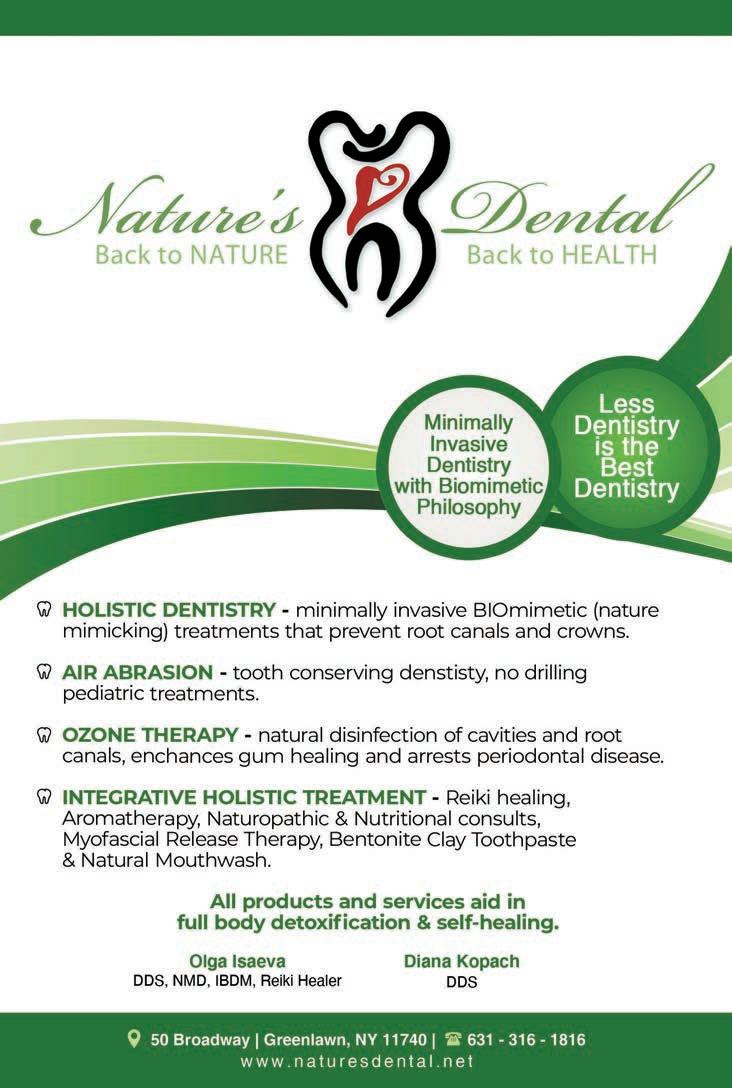
14 minute read
feature
FOOD AS MEDICINE
The Healing Power of Nutrition
Advertisement
by Julie Peterson
Eating is a ba-
sic need, but many Americans are not filling this need with healthful choices. Among the more than 700,000 Americans that die each year from heart disease, stroke or Type 2 diabetes, about 45 percent eat meals heavy in salt, processed meat and sugary drinks, and low in fruits, vegetables, fish and nuts, according to a March 2017 study in the Journal of the American Medical Association.
“I fully understand and empathize with people in the public,” says T. Colin Campbell, Ph.D., author of the groundbreaking The China Study and founder of the T. Colin Campbell Center for Nutrition Studies, in Ithaca, New York. Campbell has often stressed that public and professional understanding of nutrition is lacking.
The problems with the Standard American Diet (SAD) start with the very ground it is grown in. Large-scale farming in the U.S. has depleted the soil, producing lower nutrient foods. In addition, many foods are processed by manufacturers to improve shelf life, which further destroys nutrients and requires toxic additives.
“The default choice, the easy choice, is the inexpensive, highly processed food. Our built environment throughout the country has made it easier to find fast food than a produce store,” says Lisa McDowell, director of lifestyle medicine and clinical nutrition at Saint Joseph Mercy Health System, in Ann Arbor, Michigan.
SAD is a primary risk factor for high blood pressure, abnormal blood lipids, increased blood glucose and weight gain, according to the World Health Organization (WHO). These intermediate conditions can lead to full-blown chronic diseases such as heart disease, stroke, cancer and diabetes, all of which are on the rise. The U.S. Centers for Disease Control and Prevention reports that 60 percent of American adults have at least one chronic disease and 40 percent have two or more, making chronic disease the leading cause of death and disability in the country.
The good news from WHO is that up to 80 percent of heart disease cases, 90 percent of Type 2 diabetes cases and one-third of cancer incidences could be avoided by a healthier diet, as well as lifestyle changes like stopping smoking and increasing physical activity.
A healthy diet is not as simple as cutting out convenience foods, because many people literally can’t stop eating them. Studies have compared the addictive properties of added sugar and salt to those of nicotine and cocaine. “Additives like sugar release opioids and dopamine in the brain. The same neurochemical changes in the brain occur in addictions,” says Claire Stagg, DDS, founder of Health Connections Dentistry, in Indian Harbour Beach, Florida, and author of Smile! It’s All Connected, a layperson’s guide that explains the essential connections between the mouth and overall wellness.“People need to be educated, or re-educated, to take ownership of their health by remembering the basic premise that their bodies can be healthy if
prostock-studio/AdobeStock.com
they get the right nutrients to facilitate and support that basic process.”
Campbell agrees that more people need to be educated. A major theme in his latest book, The Future of Nutrition, is how to sift through the conflicting information that exists.
Healthier Helpings
As the food industry continues to woo Americans with fast and easy processed foods, there are consumer shifts taking place. “About a quarter of U.S. adults are trying to manage a health or medical condition by making healthy food and beverage choices,” stated the NPD Group consumer research firm in 2019. “Younger adults, ages 18 to 24, are particularly interested in using foods to improve their health.”
It turns out that it’s most beneficial to focus on adding what is needed for optimal health, instead of worrying about what to eliminate. As William Li, M.D., counsels in Eat to Beat Disease, “Human nature abhors deprivation.” As president of the Angiogenesis Foundation, in Cambridge, Massachusetts, Li advises us to “practice health care at home every day in our own kitchens.” He suggests frequently eating such simple, but disease-defying foods as dark chocolate, walnuts, kiwis, sourdough bread and sauerkraut.
“I recommend participating in bigger box stores. They do a great job at making high-quality food available at an inexpensive price,” says McDowell. She also suggests batch cooking and planning meals ahead for the week.
The Power of Plants
Plant-based eating is finally becoming mainstream, thanks in part to such eyeopening documentaries as Forks Over Knives, Earthlings, PlantPure Nation and Food, Inc. Research backs up the benefits. In a 2019 study in the Journal of the American Heart Association, Johns Hopkins researchers report that in a 30-year period, people eating a mostly plant-based diet were 32 percent less likely to die from a cardiovascular condition and 25 percent less likely to die from any cause. A 2017 report published in International Journal of Epidemiology suggests that fruits and vegetables are associated with a reduced risk of many chronic diseases and may protect against certain types of cancers.
For treatment, reversal and prevention of chronic disease, the American College of Lifestyle Medicine, in Chesterfield, Missouri, recommends eating a primarily plant-based diet containing minimally processed vegetables, fruits, whole grains, legumes, nuts and seeds.
Campbell says that moving to a 100 percent plant-based diet “and staying there for one to three months, provides an opportunity for virtually everyone to finally crave a salad on a regular basis. This is a place wherein people have little or no interest to backslide because their taste preferences have profoundly changed.”
As plant-based eating gains momentum, there are more imitation meat products. These foods can be helpful to transition away from meat, but Campbell cautions, “They do not replace the whole plant-based foods, even though they are plant-based, because salt, sugar and added oil are usually added.”
Eating by the Colors
Eating fruits and vegetables in a rainbow of vibrant colors ensures we get a variety of phytochemicals, vitamins, minerals and antioxidants. The federal Office of Disease Prevention and Health Promotion recommends consuming two and one-half cups of vegetables and two cups of fruit each day. McDowell suggests including “deeply pigmented fruits and veggies in at least five different colors, so that you’re getting all of the micronutrients and they’re all working together.”
Aim to include a couple different foods from each of the following color groups over a week’s time. Infographics and charts are available for download from the American Heart Association (Heart.org), Vegan. Easy.org, Dr. Ranjan Chatterjee (DrChatterjee.com) and others. Apps such as Eat the Rainbow Food Journal, Eat Five and VegHunter also make vegetable and fruit intake easy to track. Green: Dark greens have cancer-blocking chemicals like allyl sulfides, lutein and indoles, which inhibit carcinogens. They also contain folate for healthy cells and calcium
The Shift in the Medical Field
“We, as a society, have gotten locked into focusing on disease cure over health care,” writes T. Colin Campbell, Ph.D., author of the bestselling The China Study and the recently released The Future of Nutrition. Fortunately, as studies prove that diabetes, kidney disease, cancer and Crohn’s disease improve with changes in diet, the medical community is slowly shifting toward using nutrition in tandem with traditional care to help manage and prevent disease.
Unfortunately, says John Osborne, M.D., director of cardiology at State of the Heart Cardiology, in Dallas, “The amount of nutritional education in medical school is minimal.” Now, the American College of Lifestyle Medicine (ACLM) is aiming to fill that void by training healthcare teams to prevent and reverse chronic disease through lifestyle behaviors.
Saint Joseph Mercy Health System, in Ann Arbor, Michigan, is one example. After a group of physicians and registered dietitians received ACLM certification, it launched a Lifestyle Medicine and Clinical Nutrition program. “The goal is to provide support to individuals and teach them to hardwire best practices that optimize their own personal health and potential,” says Lisa McDowell, program director.
The Food as Medicine Institute, in Portland, Oregon, also offers a training program for healthcare professionals and nutritionists to implement communitybased nutrition programs. The Cleveland Clinic Center for Functional Medicine, in Ohio, offers programs that help patients identify genetic, lifestyle and environmental factors to shift health from illness to well-being. The Gaples Institute, in Naperville, Illinois, offers nutritional training and accreditation for medical clinicians, as well as free nutritional instruction online for the public.
anna shkuratova/AdobeStock.com

Food to Heal the Planet
Eating healthy also means making a choice for the health of the planet.
Organic, locavore and small-farm advocates are speaking out against the industrialized U.S. food system with its extensive use of pesticides, poor treatment of animals and lack of regenerative soil management. Organizations like the Rodale Institute, Regeneration International, Kiss the Ground and the Ecological Farming Association are working to train farmers to regenerate soils to not only restore climate stability, but also provide far healthier foods from nutrient-rich soils.
“I believe if we have a greater understanding of our local and regional food systems, we will be moving in a more sustainable, intentional and responsible direction for ourselves, our communities and the planet,” says Andrea Bemis, author of the farm-totable cookbook Local Dirt and operator of Tumbleweed Farm with her husband Taylor in Mount Hood, Oregon.
Local food is easier on the planet for several reasons. “Large commercial farms work the soil so intensively that they must use synthetic fertilizers to get anything to grow,” says Brock Hall, owner of Florida Fields to Forks, in Malabar, Florida. Alternatively, cover crops keep nutrients in the soil, requiring less water and naturally sequestering more carbon from the atmosphere. Shorter transit or shipping distances after picking uses less pollution-causing fuel.
“Choosing the right food is not only important for our personal health, but also is important for our planet and for our checking account,” says T. Colin Campbell, author of The China Study and The Future of Nutrition. “I have come to believe, after being in this discipline for 65-plus years, that our choice of food is the easiest and most important choices we can make to address the many existential problems that we now face.” for stronger bones, muscles and heart regulation. Get plenty of asparagus, avocados, broccoli, Brussels sprouts, green tea, kale, kiwi, spinach and green herbs. Blue and purple: Anthocyanins wipe out free radicals, boost brain health and reduce inflammation. Resveratrol can delay cellular aging, protect the heart and reduce risk of some cancers. Add blueberries, blackberries, eggplant, elderberries, figs, grapes, plums, raisins, eggplant and purple cabbage. Red: Rich in lycopene, a potent scavenger of gene-damaging free radicals, red plants lower risk of certain cancers and boost heart, brain, eye and bone health. Try apples, beets, cherries, cranberries, raspberries, red peppers, tomatoes and watermelon.
Yellow and orange: Contain vitamin C, hesperidin and carotenoids such as betacarotene to inhibit tumors, protect eyes, detoxify the body, reduce inflammation and boost the immune system and heart health. Add apricots, bananas, cantaloupe, carrots, mango, oranges, pineapple, pumpkin, sweet potatoes, tangerines and yellow peppers. White and brown: The onion family contains allicin and beta glucans, which have anti-tumor properties and can help lower cholesterol. Nuts contain healthy fats. Other foods in this group contain blood pressure-regulating potassium and antioxidant flavonoids like quercetin and kaempferol, along with digestion-boosting fiber. Choose beans, cauliflower, garlic, leeks, mushrooms, nuts, onions, parsnips and whole grains.
Gaining Gut Health
The gut contains the organs that make up the digestive tract and the gut microbiome, a balance of microorganisms that survive on food. A healthy gut can prevent and heal illnesses in the digestive tract, immune system, cardiovascular system, kidneys and brain.
If the gut is burdened with unhealthy foods and digestion is impeded, illness may arise. However, shifting to healthier, plant-based foods can cause a measurable shift in the gut microbiome in three to four
days, Duke University researchers report in Nature.Gut health can be enhanced and restored with specific foods: Enzymes to break down food are found in raw fruits, vegetables, sprouts, nuts and fresh herbs, and can be destroyed by cooking or processing. These work before the body’s digestive enzymes kick in to improve digestion, eliminate toxins and boost energy. Studies have shown that raw plants also help with weight loss, decreasing cholesterol and reducing inflammation. Probiotics, live bacteria that promote healthy gut flora, are found in fermented foods like sauerkraut, kimchi, sourdough bread, yogurt, kefir, pickles, miso and cheddar cheese.

Prebiotics, undigestible natural fibers that feed probiotics, abound in apples, asparagus, bananas, barley, burdock root, dandelion greens, flaxseeds, garlic, oats and onions.
Going Local
Whole foods grown locally provide the most nutrition. Michael Pollan, professor of science and environmental journalism at the University of California, Berkeley, and author of In Defense of Food, famously said, “Don’t eat anything your great grandmother wouldn’t recognize as food.”
Buying, preparing and eating whole foods may seem laborious at first, but the shift away from “easy foods” can quickly become a way of life as the body begins to feel better. “We hear stories every week about people who have fixed health issues from eating healthy,” says Brock Hall, owner of the Florida Fields to Forks organic community supported agriculture (CSA) farm in Malabar, Florida. He adds that everyone “ought to get closer to your food” by growing it or getting to know organic farmers at local markets, self-pick operations or through CSAs.
Healthy eating is about balance. Enjoy comfort foods occasionally, focusing on the bigger picture of more healthful foods overall.
Julie Peterson has contributed to Natural Awakenings for more than a decade. Connect at JuliePeterson2222@gmail.com.
GROW YOUR BUSINESS Secure this ad space!
Contact us for special ad rates! 212-726-1420 publisher@na-newyorkcity.com
ALL ABOUT CBD RESEARCH POINTS TO ITS BENEFITS
REGENERATIVE FARMING HOW IT CAN SAVE THE PLANET
FREE
Easy Ways to GROW EDIBLES INDOORS
March 2021 | New York City - Long Island | NYCNaturalAwakenings.com


Lyme Disease:
The Great Mimicker
From the Desk of Dr. Howard Robins at The Healing Center in New York City…
What’s Wrong with Me?
Michael came into the office taking short baby steps. His 19-year-old arms and hands were bent and twisted into a weird, spasmodic position. His head tilted to the side, eyes nearly closed, with his face in a strange grimace. He spoke in short three- or four-word sentences. He had been suffering since he was 13 years old, and his father was ready to institutionalize him for the rest of his life. Until he became ill, he was a normal boy and a computer whiz. One day, he developed what appeared to be the flu, except it was in the summer and not the flu season.
Several courses of oral and intravenous antibiotics failed to work. His symptoms worsened over the years, and several Lyme experts later left him in the state in which he arrived into our office. He had late-stage Lyme disease. elbows, wrists, hips and shoulders. Pain is often mild or moderate, usually with swelling at the involved joint. In some cases, Lyme disease kills.
The Answer
The Cause
In many but not all cases, antibiotics may eliminate the infection and its symptoms, especially if the illness is treated early. Unfortunately, even when caught early, antibiotics don’t always work. Many people are allergic to the drugs needed or develop sensitivity reactions and have to stop them. Delayed or inadequate treatment (often treating for too short a period of time) can lead to the more serious symptoms, which can be disabling and even harder to treat—that is, unless medical ozone is used.
Over the past 22 years, intravenous medical ozone has been safely and effectively used to destroy and eliminate Lyme disease, even in late-stage infections. Often when all hope is gone, even after years of suffering, medical ozone has proven successful. Usually in just a few weeks, symptoms begin to diminish, offering hope and finally giving relief. Intravenous medical ozone when it enters the body attacks and kills all Lyme disease-causing bacteria. It does it safely, virtually with no adverse reactions. In addition, it destroys all unwanted viruses, fungus, yeast, mold, harmful free radicles, and toxins, thus cleansing your body and boosting your own natural immune system. And did I say it does it safely and with virtually no adverse reactions?
The disease is named after the towns of Lyme and Dr. Howard Robins Old Lyme, Connecticut, where a large number of cases were identified in 1975. It is a worldwide pandemic. The infection is transmitted to humans by the bite of infected ticks. The ticks are extremely small and often fall off the body after feeding, thus masking the fact that you’ve been bitten.
The Symptoms and the Difficulty in Diagnosis
Early symptoms may include fever, headache, fatigue, depression and a characteristic circular skin rash, which has a “bullseye” (target-like) appearance. The “bulls-eye rash” is thought to occur in only about 80 percent of infected patients, adding to misdiagnosis. Patients often experience flu-like symptoms, such as headache, muscle soreness, fever, and malaise, which can also confuse early diagnosis.
Lyme arthritis usually affects the knees and feet, and, in some patients, arthritis can occur in other joints, including the ankles, More information about this amazing, safe and effective treatment is available at OzoneWithoutBorders.ngo, on my website OzoneDoctor.net, and on my radio show, which is archived but live each week on VoiceAmerica.com, Health and Wellness Channel, “Functional Medicine with Dr. Robins.” Or call my office at 212-581-0101. See ad, page 3.










